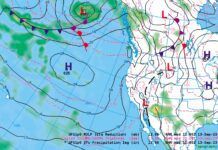- Remember that web sites outside the FAA and NWS domains should be considered supplementary tools to be used in combination with a weather briefing through official sources.
- When looking at forecast data, scroll a few hours past your arrival time. This will give you an idea of what might be in store if the weather system speeds up or your inbound time is delayed.
- Remember to use the Aviation Weather Center TAF viewer or ADDS Flight Path Tool to help you select the alternate.
- During your preflight, set out several checkpoints along the route, and using your weather tools, note the forecast weather conditions at each one. This will alert you to unforecast changes in the conditions during the flight. If things look worse than you expected, call FSS for an update.
- When using meteorological websites, 200 mb corresponds roughly to FL390, 300 mb is close to FL300, 500 mb is near FL180, 700 mb is near 10,000 feet, and 850 mb is near 5000 feet. We say approximately, because it varies by about 5-10 percent upward or downward depending on the air mass temperature—downward in cold air and upward in warm air.
Current Icing Product, a package produced by the Aviation Weather Center, presents a categorical prediction of icing severity and probability. It is actually a sophisticated system that applies fuzzy logic and decision trees to over 50 different meteorological fields. - Supercooled large drops (SLD) freeze slowly on airframe surfaces, allowing any trapped air to escape and giving the ice a transparent character.
- Graphical Turbulence Guidance (GTG) is best at forecasting clear air turbulence. Low-level turbulence is more difficult to accurately predict
Tim Vasquez is a professional meteorologist in Palestine, Texas. See his website at www.weathergraphics.com.




